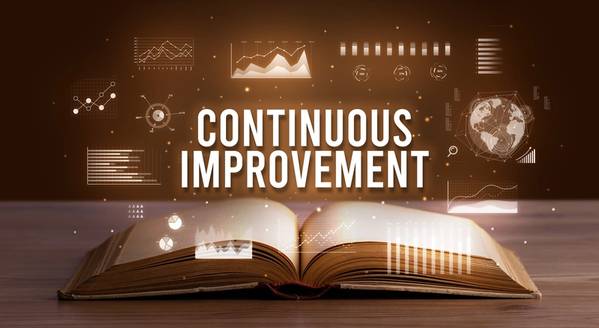
The principles of continuous improvement are well known in the arenas of quality and management. Yet very few training centers and operators apply these simple principles to the management of their training programs. Being deliberate and thoughtful about training quality requires very little effort, yet is one of the most impactful activities that can be undertaken. Even a modest program can result in a higher degree of employee professionalism, in better trainee satisfaction, and in improved, safer performance. So how do we apply the principle of continuous improvement to our training programs?
Continuous improvement is an ongoing, cyclical process of reflecting on training quality metrics and using them to identify and eliminate suboptimal practices. This cycle is undertaken in a series of incremental, rather than drastic steps proceeding as follows:
Let’s delve briefly into each of the steps above.
First, and most important is choosing our training metrics. The metrics must obviously be items we have the ability to measure and the desire to optimize. To be useful for the continuous improvement process they must also be measurements that we have some influence over (i.e., we have the ability to improve). Many times, this Training Tips for Ships column has discussed ways of measuring training, and those metrics will all be useful here.
Training metrics are available from a variety of sources. The most accessible are those metrics we are already collecting from trainees. For example, exam scores, trainee satisfaction surveys and evaluations of instructors are all measurements we are likely already collecting and can be used as metrics to optimize.
We can dig deeper into the data we already have by, for example, dissecting exams and grouping question performance by competency to individually measure the uptake of each. A similar analysis could be used to identify commonly held misunderstandings - and use that information to minimize those occurrences. Given some thought, it becomes easy to identify valuable information in the data that our organization is already gathering.
We can also go beyond the data we are already gathering. We could ask trainees to rate the quality and relevance of their training after some time has elapsed, enabling them to reflect on its actual value in practice rather than expected value. We can ask our trainers for their regular feedback on important training issues and topics. We could measure the performance of employees in the field and correlate it back to their past training. We can also look at longer-term metrics such as accident rates, near misses, employee attrition, and many others. But initially, it is best to keep the list short and focused. Over time metrics can be refined and added.
Once we have our metrics, the cycle requires us to brainstorm changes to our practices that have the potential to improve those metrics. These changes are specific to the metrics they are intended to improve, but best practice is to make only one change (or a very small number of changes) at a time - otherwise it becomes difficult to identify which change(s) resulted in improvement.
After we have waited for our changes to have their desired effect, it is time to re-evaluate the metrics to see if there has been a change. In those instances where we see improvement, it is reasonable to keep the change(s), and in those cases where there has been no improvement (or worse, a negative effect), the change(s) can be reversed. The continuous improvement cycle period depends on the changes being made and our organization’s training cadence, but often organizations complete a cycle once or twice per year.
There is much more to the process of applying continuous improvement to training, but getting started is the most important step. As indicated, even the most modest of processes will yield results. If we don’t measure it, we cannot manage it - and excellent training is never an accident.
Until next time, thank you for reading and sail safely.



